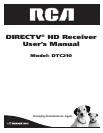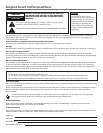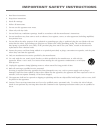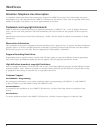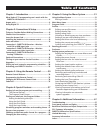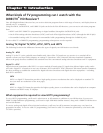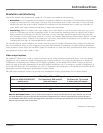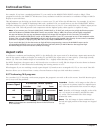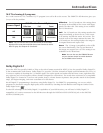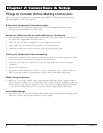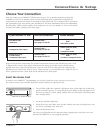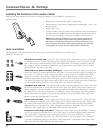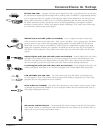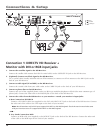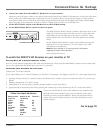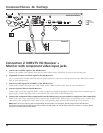
Introduction
6 Chapter 1
Introduction
Chapter 1 7
Aspect ratio
In addition to resolution and interlacing, HDTV is also dened by the aspect ratio of its broadcasts. Aspect ratio means the
ratio of the screen’s width to its height. For analog TV and SDTV, the aspect ratio is 4 units wide by 3 units high (usually
written 4:3). This is the familiar shape of conventional TVs — slightly wider than they are tall.
For HDTV broadcasts, the aspect ratio is 16:9 (nearly twice as wide as it is tall), like the shape of movies shown in theaters.
This makes HDTV an ideal format for broadcasting and viewing movies on a TV.
What happens if you are watching a nearly square-shaped 4:3 broadcast on a rectangular 16:9 TV, or vice-versa? Your HD
Receiver allows you to choose from a variety of screen formats to help you deal with those scenarios.
4:3 TVs showing 16:9 programs
For a standard 4:3 TV showing a widescreen program, the program is too wide to t on the screen. Your HD Receiver gives
you 3 ways to x the problem:
Letterbox Shrinks a 16:9 image so that it ts on
a 4:3 screen in its entirety and in its original aspect
ratio. The top and bottom of the screen are empty.
Full Stretches a 16:9 image vertically so that it ts
on a 4:3 screen in its entirety and lls the entire
4:3 screen. The horizontal scale of the image
remains the same.
Zoom The 16:9 image is shown unaltered, but
the left and right portions of the image are cropped
(or cut).
Source Signal
4:3 Monitor Format Options
Letterbox Full Zoom
4:3
Not available Not available
16:9
Note: 4:3 broadcasts are automatically shown in the Full format
on 4:3 monitors.
For example, if you have a standard-resolution TV, you would set the RESOLUTION SELECT switch to 480p/i. Then
programs received by the DIRECTV
®
HD Receiver at any resolution would be converted to a resolution of 480p or 480i for
display on your television.
This information can also help you decide how to connect your TV and VCR to the HD Receiver. For example, if you have
a High-Denition TV capable of displaying 1080i, and a standard VCR, you would want to use the COMPONENT, RGB or
DVI jacks (whichever your TV accepts) to connect the HD Receiver to your TV. You would then use a VIDEO output jack to
connect your VCR. This will provide each component with the highest quality video signal it is capable of using.
Note: If you connect your TV to the VIDEO OUT, S-VIDEO OUT, or TV OUT jack, and you view a high-denition program
with the HD Receiver’s RESOLUTION SELECT switch set to either 720p or 1080i, the picture will be slightly cropped at
the top and bottom (the very top and bottom edges of the image will not appear on the TV screen). To avoid this
problem, set the RESOLUTION SELECT switch to the 480p/i position if your TV is connected to one of the composite video
outputs. Also, since the RGB, COMPONENT and DVI jacks do not output the 480i video format, do not connect a standard
denition TV capable of displaying only 480i video to the RGB, COMPONENT or DVI jacks.
If you use the DVI jack, for the best access to high-denition programming, connect the DVI/HDCP output to the
corresponding DVI/HDCP input on your High-Denition Television (HDTV) or HDTV Monitor that supports High-
bandwidth Digital Content Protection (HDCP) technology.



